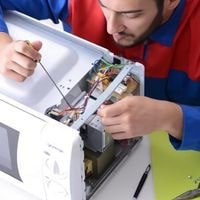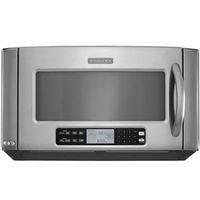KitchenAid Microwave not working. The microwave is one of the greatest time-saving devices in your home. Unfortunately, it can also quickly warm up your frustrations if it isn’t working properly.
If you’re dealing with a KitchenAid built-in microwave that won’t turn on, the troubleshooting guide below may help identify and resolve the issue.
KitchenAid Microwave not working
There aren’t many tasks that are quicker or easier than warming up a meal in your microwave.
But in some unfortunate instances, the convenience of breaking out an easy breakfast, lunch, or dinner can be left unfulfilled when your appliance will just not start.
Fortunately, reading over this repair guide may help you pinpoint and fix the malfunction when your built-in KitchenAid microwave refuses to works.
Faulty line fuse
If too much current passes through the microwave circuitry, the microwave might not start. If the microwave will not start, first check if there is a problem with the line fuse.
Use a multimeter to test if there is continuity in it. If no continuity exists, then replace it with a new one and also investigate and resolve any underlying issues that caused it to blow out in the first place (since it is quite likely that this would happen again).
Otherwise, there could be an electrical malfunction somewhere within the circuit(s) of your device. A faulted microwave should never be used as doing so can result in electrical shock or worse.
The thermal fuse has blown
In the event of overheating or malfunction, the thermal fuse will shut off the microwave. Check the continuity of the thermal fuse with a multimeter to be certain it has blown.
If the fuse isn’t conducting electricity, provide continuity and may need to be replaced. Unfortunately, the thermal fuse cannot be reset; if it has indeed blown up, it must be replaced.
(Note: Do not use electric appliances when you have a heart condition or take medications that affect your heartbeat, these cookers store thousands of volts in their high-voltage capacitors which can leak electric current for many years after an appliance has been unplugged.)
Defective Main Control Board
An important board in the microwave is the mainboard. This board is responsible for a lot of what goes on inside it, including the most basic tasks such as powering up and operating your microwave.
With the exception of water leakage and other severe issues, these boards tend to be unaffected by external environmental factors.
If your microwave has recently stopped working properly you should test out individual parts before reaching for a new mainboard making sure that any small issues won’t compound into something more severe over time.
Replace Thermoprotector
If the microwave overheats, the Thermo protector trips to cut off voltage to ensure that there is no danger. To determine whether or not a new Thermo protector is needed, use a multimeter to test its continuity.
If it doesn’t have continuity and cannot be reset, then new parts will need to be ordered and replaced accordingly
The Door Switch issue
When you turn on your microwave and close the door, it is said that the magnetron inside generates microwaves that are absorbed by food items.
This is one of the benefits of cooking or reheating food in a microwave oven because microwaves can penetrate deep into the food and this helps heat up your food evenly. One downside, however, is that these powerful microwaves may affect other parts of your appliance.
For instance, opening the door stops the flow of microwaves to stop heating more quickly. A malfunctioning switch would prevent an appliance from shutting off even if its door was opened.
Repairing or replacing the defective switch could resolve this problem so the operation can continue properly.
Related Guides
